Related Research Articles
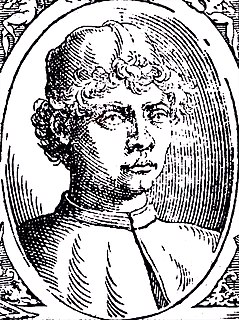
Piero della Francesca, originally named Piero di Benedetto, was an Italian painter of the Early Renaissance. To contemporaries he was also known as a mathematician and geometer. Nowadays Piero della Francesca is chiefly appreciated for his art. His painting is characterized by its serene humanism, its use of geometric forms and perspective. His most famous work is the cycle of frescoes The History of the True Cross in the church of San Francesco in the Tuscan town of Arezzo.

Andrea del Castagno or Andrea di Bartolo di Bargilla was an Italian painter from Florence, influenced chiefly by Masaccio and Giotto di Bondone. His works include frescoes in Sant'Apollonia in Florence and the painted equestrian monument of Niccolò da Tolentino (1456) in the Cathedral in Florence. He in turn influenced the Ferrarese school of Cosmè Tura, Francesco del Cossa and Ercole de' Roberti.

Santa Maria Novella is a church in Florence, Italy, situated opposite, and lending its name to, the city's main railway station. Chronologically, it is the first great basilica in Florence, and is the city's principal Dominican church.

The Badìa Fiorentina is an abbey and church now home to the Monastic Communities of Jerusalem situated on the Via del Proconsolo in the centre of Florence, Italy. Dante supposedly grew up across the street in what is now called the 'Casa di Dante', rebuilt in 1910 as a museum to Dante. He would have heard the monks singing the Mass and the Offices here in Latin Gregorian chant, as he famously recounts in his Commedia: "Florence, within her ancient walls embraced, Whence nones and terce still ring to all the town, Abode aforetime, peaceful, temperate, chaste." In 1373, Boccaccio delivered his famous lectures on Dante's Divine Comedy in the subsidiary chapel of Santo Stefano, just next to the north entrance of the Badia's church.

Francesca da Rimini or Francesca da Polenta was a medieval Italian noblewoman originally from Ravenna, known for having been murdered by her husband, Giovanni Malatesta, upon his discovery of Francesca's affair with her brother-in-law, Paolo Malatesta. She was a contemporary of Dante Alighieri, who portrayed her as a character in the Divine Comedy.
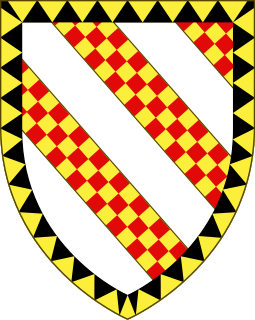
The House of Malatesta was an Italian family that ruled over Rimini from 1295 until 1500, as well as other lands and towns in Romagna and holding high positions in the government of cities in present day Tuscany, Lombardy and Marche. The dynasty is considered among the most important and influential of the Late Middle Ages. In the period of maximum influence, they extended their domains along the Marche coast, up to Ascoli Piceno, Senigallia, Sansepolcro and Citerna, and to the north, on the territories of Bergamo and Brescia.
Francesca da Rimini, Op. 4, is an opera in four acts, composed by Riccardo Zandonai, with a libretto by Tito Ricordi, after the play Francesca da Rimini by Gabriele D'Annunzio. It was premiered at the Teatro Regio in Turin on 19 February 1914 and is still staged occasionally.

The da Polenta or Polentani were an old noble Italian family whose name derives from the Castle of Polenta near Bertinoro in Romagna.
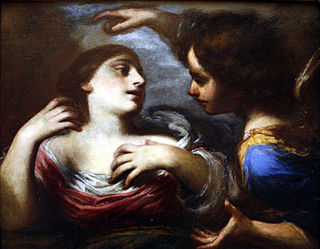
Cecco Bravo was an Italian painter of the Florentine Baroque school. His true name is Francesco Montelatici.
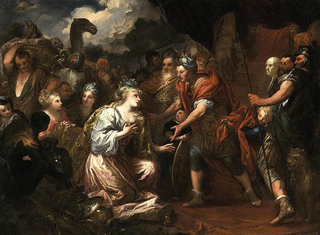
Pietro Dandini was an Italian painter of the Baroque period, active mainly in Florence.

Paolo Malatesta, also known as il Bello, was the third son of Malatesta da Verucchio, lord of Rimini. He is best known for the story of his affair with Francesca da Polenta, portrayed by Dante in a famous episode of his Inferno. He was the brother of Giovanni (Gianciotto) and Malatestino Malatesta.
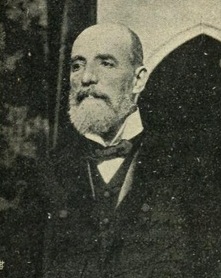
Cesare Maccari was an Italian painter and sculptor, most famous for his 1888 painting Cicerone denuncia Catilina.
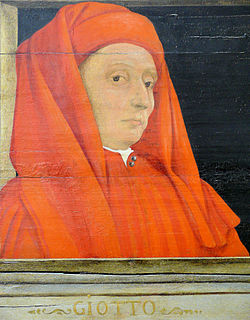
Giotto di Bondone, known mononymously as Giotto and Latinised as Giottus, was an Italian painter and architect from Florence during the Late Middle Ages. He worked during the Gothic/Proto-Renaissance period. Giotto's contemporary, the banker and chronicler Giovanni Villani, wrote that Giotto was "the most sovereign master of painting in his time, who drew all his figures and their postures according to nature" and of his publicly recognized "talent and excellence". Giorgio Vasari described Giotto as making a decisive break with the prevalent Byzantine style and as initiating "the great art of painting as we know it today, introducing the technique of drawing accurately from life, which had been neglected for more than two hundred years".
The Traversari are a noble Italian family. The dynasty's history was mostly connected to Ravenna, which it ruled between the 12th and 13th centuries. St. Romuald was the son of Duke Sergio degli Onesti of Ravenna and of Traversara Traversari, daughter of Teodoro Traversari, son of Paolo I Traversari.
Jacopo Alighieri (1289–1348) was an Italian poet, the son of Dante Alighieri, whom he followed in his exile. Jacopo's most famous work is his sixty-chapter Dottrinale.
Adeodato Malatesta was an Italian painter, trained in a grand Neoclassical style, depicting mostly of sacred and historic subjects.

The Palazzo Malvezzi de' Medici is a Renaissance-style palace located on Via Zamboni #13 in central Bologna, Italy. The palace now houses the offices of the Provincial Administration.
Giuseppe Soleri Brancaleoni (1750-1806) was an Italian painter, active mainly in Rimini, painting sacred subjects.

The Tomb of Dante is an Italian neoclassical national monument built over the tomb of the poet Dante Alighieri in 1781. It is sited next to the Basilica of San Francesco in central Ravenna.

The second circle of hell is depicted in Dante Alighieri's 14th-century poem Inferno, the first part of the Divine Comedy. Inferno tells the story of Dante's journey through a vision of the Christian hell ordered into nine circles corresponding to classifications of sin; the second circle represents the sin of lust, where the lustful are punished by being buffeted within an endless tempest.
References
- ↑ Also see description in La Sapienza ispirata dalla religione: pitture nella sala degli esperimenti nel Collegio delle Scuole Pie Fiorentine, by Numa Pompilio Tanzini, published 1838.
- ↑ Saltini, Guglielmo Enrico (1862). Le Arti Belle in Toscana da mezzo il Secolo XVIII ai di Nostri (book). Florence, Italy: Tipografia Le Monnier. p. 58.